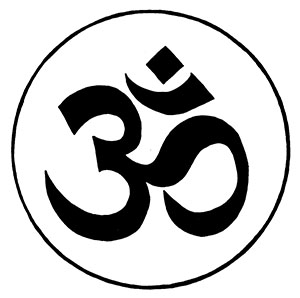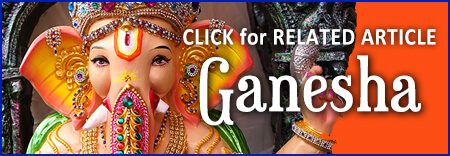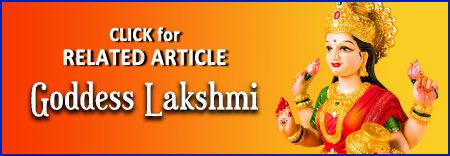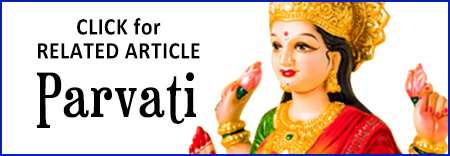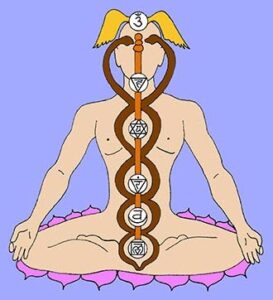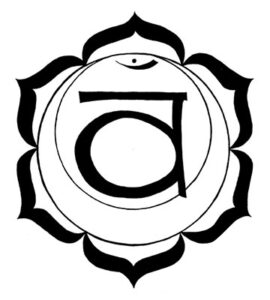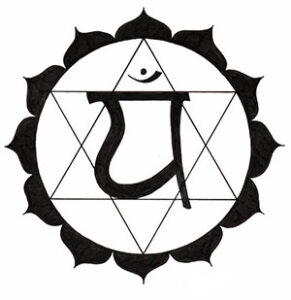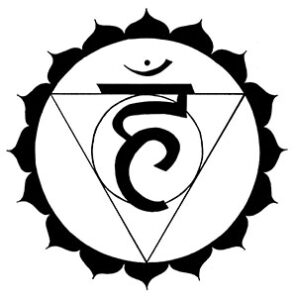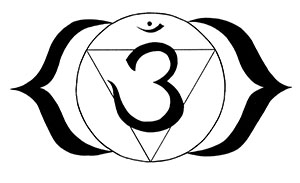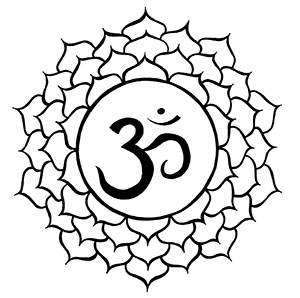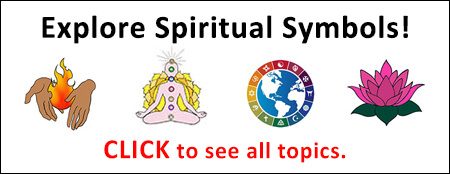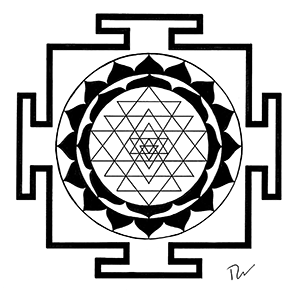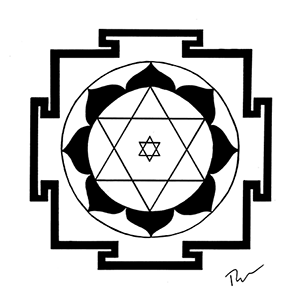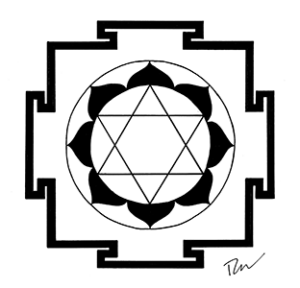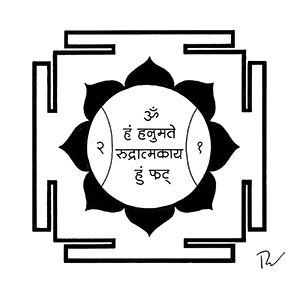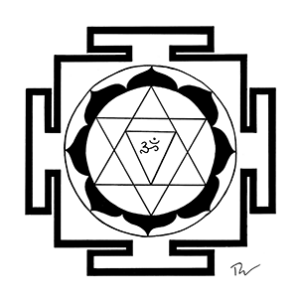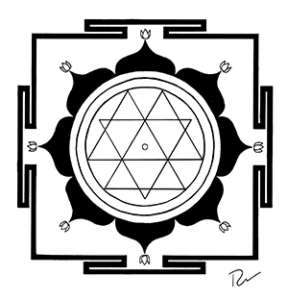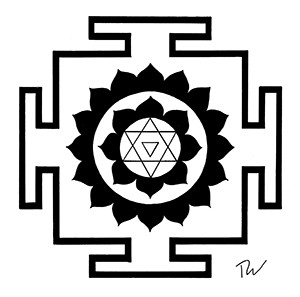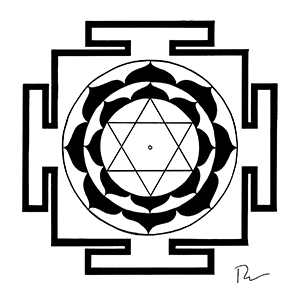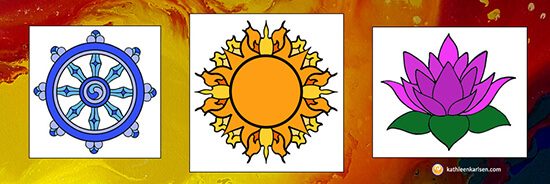
Yoga Symbols
Over 50 Fascinating Symbols with Meanings
This article features over 50 yoga symbols include Sanskrit characters, yantras, goddess symbols, chakra symbols and more. Use these images as visualizations to tap into the energy of ancient symbols with powerful meanings. Perfect for meditation, yoga, and for decorating beautiful spaces.
Table of Contents
Share this page with a friend!
Yoga Symbols: Sanskrit Characters (OM & AIM)
There are symbols in Sanskrit that stand for single word mantras or for concepts such as peace. One word mantras are often called bija mantras. There are one-word mantras for each of the chakras as well as for specific forces such as electricity and magnetism. For more information, visit One Word Mantras or Chakra Sounds.
OM: Essential Yoga Symbol
The Sanskrit word OM is familiar to most people as the most well-known symbol of yoga. OM is the fundamental sound connecting us to higher reality and the highest aspect of our own beings. OM is believed to be a sound of the whole cosmic manifestation.
Four Parts of AUM
OM can be viewed as having four parts: A-U-M followed by the sound of silence. The A (ahhh) represents the beginning, the connection to the physical world. The U (oooh) signifies the main[1]taining of the physical universe. The M (mmmm) is the trans[1]formative energy of the universe and the realm of thoughts and feelings. As noted, the fourth sound is the silence that follows the AUM. This is pure consciousness and knowingness.
OM in Mantras
OM is often included at the beginning of a mantra or chant to clear the mind for meditation. OM is said to draw the energy from the bottom of the spine to the top of the head. The energy of OM is one of expansion and ascension. Om can be used in mantras for the chakras as well as devotions to various forms of Buddhas, gods and goddesses. Find links to listen to Eastern Mantras.
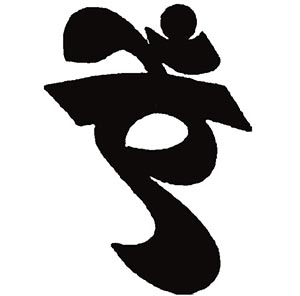 AIM: Symbol of the Divine Feminine
AIM: Symbol of the Divine Feminine
AIM (ieem) is the feminine counterpart of the bija mantra OM. The “AI” in AIM is pronounced “eye.” AIM is a manifest form of OM, that which is created and seen versus that which is purely in consciousness. AIM is the supreme shakti or feminine force known as Adi Shakti. AIM appears in many mantras to the goddesses and the Divine Mother.
Bija Seed Syllable of the Goddess Saraswati
AIM is the seed mantra of Saraswati, goddess of knowledge, wisdom, music, art and speech. I view a seed mantra as the basic essence of an aspect of consciousness personified in a deity. Saraswati is revered in Hinduism, Jainism and some Buddhist sects. Her name means “one who leads to the essence of self-knowledge.” Learn more at One Word Mantras.
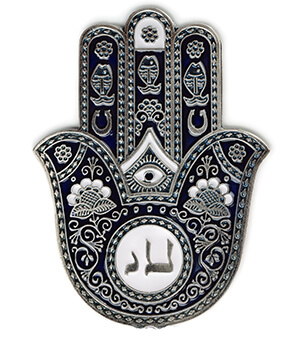
Hamsa Yoga Symbol (Hand & Five Fingers)
The hand is a universal symbol in many cultures. The Hamsa yoga symbol represents the five chakras, the five elements, and the five senses. This symbol is believed to ward of negative energy. For this reason, the Hamsa symbol is sometimes called the evil eye symbol. Each finger in the symbol is correlated with a particular chakra and element.
Thumb Meaning: Solar plexus chakra, fire element
Forefinger Meaning: Heart chakra, air element
Middle Finger Meaning: throat chakra, space or ether element
Ring Finger Meaning: Root chakra, earth element
Pinkie Finger Meaning: Sacral chakra, water element
Upward Hamsa Yoga Symbol
When the Hamsa hand is pointing upwards, this is the position for protection. This is a common signal in many cultures to stop. In this position, the Hamsa is often correlated with the Abhayamudra, a gesture to dispel fear and bring protection.
Downward Hamsa Yoga Symbol
When the Hamsa hand is pointing downwards to the earth, a source of abundance and good fortune, this position is similar to the Bhumisparsha mudra. This is the hand gesture used by Gautama Buddha to call the earth to witness to his enlightenment.
History of the Hamsa Hand Symbol
The modern Hamsa yoga symbol can be traced back to ancient Mesopotamia. From there, the symbol appears in Christianity, Judaism, Islam and Buddhism. This is a common symbol on jewelry, tapestries and home décor.
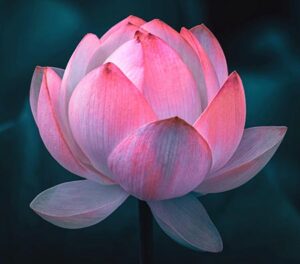
Lotus Flower as a Yoga Symbol
The lotus symbolizes purity, enlightenment and transcendence. Lotus petals are part of every chakra representation. Depending on the chakra, there may be anything from two to fifty petals or the proverbial “thousand-petalled lotus” of the crown chakra. In chakra art the lotus is usually viewed from the top, with the petals extending out on the rim of a circle. See below for more about chakra symbols.
Divine Meaning of the Lotus Flower
The lotus illustrates the unfolding of the divine essence within. The lotus is like the navel of creation. The lotus is sometimes depicted as springing from the navel of Vishnu and giving birth to Brahma, two of the gods in the Hindu trinity.
Lotus Meaning and the Heart
The lotus is also a symbol of the heart, especially the inner or secret chamber of the heart. This is sometimes called Brahma’s cave or the city of Brahma in the East or the inner castle in the West. This is the core of being that remains untouched by everyday living.
Lotus Petals and Sanskrit Sounds
The lotus petals depicted for each chakra correspond to sounds or letters of the Sanskrit alphabet. For example, the ten petals of the solar plexus chakra are associated with the Sanskrit syllables: dam, dham, nam, tam, tham, dam, dham, nam, pam, and pham. Learn more in the article on Chakra Symbols.
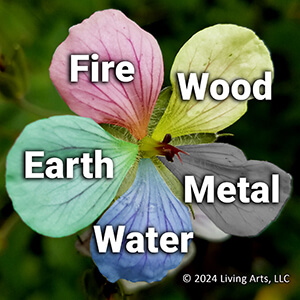
Five Element Yoga Symbols
The five element system is a powerful way to view the world and the process of transformation. Many traditional cultures categorize various aspects of life according to a system of natural elements. Natural element systems describe the relationship between different energies and phenomena in the world around us. Each of the five elements have characteristics that can be identified as personality types.
Chinese and Vedic Five Element Symbols
The Chinese five element system uses wood, fire, earth, metal, and water as the primary natural elements. The Vedic five element system is like the Chinese system but developed separately in India. The Vedic system also uses the elements of water, earth, and fire. However, the fourth and fifth elements in the Vedic system are space and air (rather than wood and metal).
Fire Element Symbolism: Fire energy is characterized by its ability to give off warmth and attract others. Predominately “fire” types place a great deal of emphasis on interpersonal relationships. Accordingly, they are romantic and idealistic, enthusiastic, and emotional. The danger of too much fire is an excess of anger or passion.
Earth Element Symbolism: The earth element can absorb excesses of the other elements. Earth personalities are forgiving and compassionate. Earth types are wonderful friends and great listeners. The main concern with being an earth type is the tendency to take on the burdens of others to a degree that is detrimental to yourself.
Water Element Symbolism: Water can change effortlessly without losing its essential nature. Water types are resourceful and single-minded, flowing over problems like a river. Water types can also store or “pool” their resources to be in a position of strength when opportunities arise. On the other hand, if a person has too much water, they may become overly emotional or stagnant.
Air Element Symbolism: Air personalities are often highly intelligent, analyzing life at every turn. They literally breeze through life, moving quickly and making decisions easily. Something to watch out for as an air personality is unpredictability or detachment.
Space or Ether Element Symbolism: The element of space is the most subtle and has the least defining characteristics. Space or ether is close to the concept of “emptiness.” In Sanskrit, this element is called akasha. This means the background against which everything is perceived. A person with this predominant element is someone who focuses on the eternal. Staying tethered to this world might be an issue for space (ether) personalities.
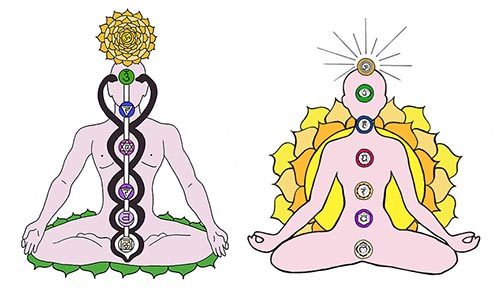
Symbols of Goddesses, Buddhas & Deities
There are many powerful symbols associated with both the masculine and feminine hindu deities. These yoga symbols of the gods and goddesses help to clarify the energy associated with these divine beings and their role in the Hindu pantheon.
Click to learn more about the Goddess Durga.
Goddess Durga Symbols
The many yoga symbols associated with Durga include the seven items that she holds in her hands as well as the lion or tiger that she rides. References to these weapons and her powers appear in many Durga mantras.
Conch Shell Symbol: Durga’s conch shell is connected to the word OM, the sound and source of all creation. The conch shell is used as a musical instrument. This is the sound that awakens the crown chakra, the place of final enlightenment. Om is the first word in many of Durga’s mantras.
Sword Symbol: Durga’s sword symbolizes knowledge of the sacred word, a weapon that overcomes all others. Durga’s sword also serves the practical purpose of self-defense against demons.
Disc or Chakra Symbol: The disc held in Durga’s hand symbolizes the spinning wheel of the chakras. The chakra disc was given to Durga by Lord Vishnu. This chakra disc also represents the revolving of the universe around Durga as a representative of the Divine Mother.
Lotus Flower Symbolism: The lotus flower is a symbol of Durga’s compassion for her devotees in their struggles to attain liberation. The lotus grows in the mud but radiates beauty and fragrance.
Bow and Arrow Symbols: Durga holds both a bow and arrow in a single hand. This indicates complete mastery over energy, both potential (the bow) and kinetic (the arrow).
Snake Symbol: The snake held in Durga’s hand is symbolic of the kundalini energy. This is the feminine energy that lies coiled at the base of the spine, waiting to be drawn to meet the masculine energy in the crown chakra.
Thunderbolt Symbol: Holding a thunderbolt indicates firmness in convictions. The vajra weapon represents the power of thunder. The thunderbolt shows that Durga attacks in complete confidence without fear.
Related article Weapons of Goddess Durga.
Click to learn more about the Goddess Ganga Mata.
Goddess Ganga Mata Symbols
Ganga Mata is a Hindu goddess personifying the Ganges River. She is a deity associated with forgiveness and purification. Water is a symbol of purity in many spiritual traditions, used for cleansing and baptism. Hindus bathe in the river Ganges for spiritual and ritual purposes.
Makara or Crocodile Symbolism: The goddess Ganga Mata is often depicted riding on a crocodile. Sometimes Ganga Mata rides on a makara, an animal with the head of a crocodile and the tail of a dolphin. The crocodile represents the lower self or the reptilian mind over which Ganga has gained mastery.
Ganges River Symbolism: The Ganges river is viewed as a gateway to heaven. The ashes of the deceased are thrown into the river to be carried peacefully from this world to the next. Bathing in the Ganges river is also viewed as a spiritual ritual. The Vedas and Puranas, ancient Hindu scriptures, view the Ganges as the most sacred river on earth.
Water Symbolism: Like oceans and other bodies of water, rivers are constantly changing, thus symbolizing limitless opportunities and possibilities. Water represents the emotional world. Water has also been symbolic of the highest good in life and the source of life. Agricultural peoples worship water in the form of rivers, clouds, mist and rain.
Click to learn more about Ganesha.
Ganesha the Elephant God Symbols
Ganesha is a joyful being associated with extensive symbolism. Ganesha’s symbols help the viewer to understand the significance of this unusual deity. Explanations for Ganesha’s more common symbols are given below. These symbols are based on artwork and statues depicting Ganesha.
Ganesha’s Large Belly Meaning: Ganesha’s large stomach indicates that he contains all of the universes (cosmic eggs) of the past, present, and future. Ganesha’s belly also represents the ability to digest all experiences in life. Finally, the large belly of Ganesh symbolizes prosperity and abundance. This includes an abundance of food and all material possessions.
Ganesha’s Elephant Head Symbolism: Elephants use their heads to break paths through the forest. This symbolizes breaking through obstacles on every level. In addition, elephants have small eyes in proportion to their large heads. This symbolizes the ability to focus and concentrate.
Ganesha’s Small Eyes Meaning: In addition, elephants are purported to see things bigger than they actually are. This is connected with the psychological symbolism of humility and the surrendering of pride. On the other hand, the mouth of an elephant is proportionately large. This represents the natural desire to enjoy food and life.
Ganesha’s Large Ears Symbolism: Ganesha’s large elephant ears represent willingness to listen and bring together ideas. This creates success in human affairs. Ganesha’s large ears also indicate the wisdom of hearing all sides of an issue. In the natural world, the large ears of the elephant help to keep them cool in a hot desert environment. The blood vessels of the ears are close to the skin and release heat.
Ganesha’s Trunk Symbolism: Ganesha’s trunk is able to hold anything in the universe. This symbolizes the idea that successful people hold whatever life brings. The trunk of an elephant has the ability to uproot large trees or to pick up a small needle. This signifies mastery in both the physical world and in the world of more subtle energy and vibrations. Next to the trunk are two tusks.
Broken Tusk Symbolism: Sometimes one of the tusks (the left one) is depicted as broken. Ganesha’s two tusks represent wisdom and emotion – the right being wisdom and the broken left representing emotion. His broken tusk tells people that they must overcome their emotions with wisdom.
Ganesha’s Arms Meaning: Ganesha’s four-armed form represents the inner attributes of the subtle body: mind, intellect, ego, and conscience. In addition, Ganesha’s four arms possess four different symbolic objects: an axe, a lotus, a plate of sweets and a symbol of OM in his palm.
Click to learn more about Lakshmi.
Goddess Lakshmi Symbols
The goddess Lakshmi is associated with gold coins as well as rice and basil. She dispenses gold coins from one of her other four hands. Sometimes Lakshmi dispenses rice from her other hand, symbolizing an abundance of food. The rice lands in a bowl of gold coins set just in front of her.
Lotus Flower Symbol: Lakshmi is usually shown seated or standing on a lotus. The lotus symbolizes creation, beauty, harmony, diversity, stability, and support. Lakshmi (or Laxmi) appears in Hinduism, Jainism, and Buddhism.
Six Symbolic Gifts of Lakshmi: Lakshmi is endowed with six auspicious or divine qualities known as gunas. These gifts include imperial authority, martial energy, priestly authority, dominion, splendor, and nourishment. In the ancient scripture known as the Shapati Brahmana, Lakshmi is described as beautiful and resplendent with immense powers and energy.
Click to learn more about the Goddess Lalita.
Goddess Lalita Symbols
Lalita is a Hindu goddess whose name means “she who plays.” The goddess Lalita is famously independent, announcing to all, “Whatever I say or do is according to my will alone. Whichever man accepts me as his with must also accept my complete independence.” Lalita is the consort of Shiva, signified by the garland she places around his neck.
Arrow and Bow Symbolism: Lalita is portrayed as a young woman holding five arrows, a bow, a noose, and a goad. The arrows are our five senses and the bow is our mind.
Goad and Noose Symbolism: When we find ourselves pausing on the spiritual path, Lalita gently prods us along with her goad. If we resist her, she lassos us with her noose and drags us back to her lap. Lalita is one of the many forms of the Divine Mother.
Click to learn more about the Medicine Buddha.
Medicine Buddha Symbols
The Medicine Buddha is depicted sitting in the lotus position, adorned with rich robes. He has a serene expression with eyes partially or fully closed. The following are typical symbols associated with the Medicine Buddha. The Medicine Buddha mantra is often used by health practitioners or those in need of healing at all levels.
Healing Plant: The Medicine Buddha is often depicted holding a medicinal plant called myrobalan in his hand. Some believe the plant reduces inflammation and internal bleeding.
Medicine Jar: The Medicine Buddha often holds an alms bowl or a medicine jar in the other hand. The jar dispenses amrit or amrita, a nectar of immortality.
Symbolic Gemstone: The Medicine Buddha is associated with the semi-precious gemstone lapis lazuli. Statues of the Medicine Buddha are often carved out of this stone. Other statues are painted blue.
Click to learn more about the Goddess Parvati.
Goddess Parvati Symbols
Like all images of the Hindu deities, depictions of Parvati carry multiple symbolic meanings. First of all, Parvati carries a trident, also known as a trishula. The three-pronged trident removes evil on the physical, mental and spiritual levels.
Trident Meaning: In the human body, the trident represents the place where the three main nadi or energy channels meet at the third eye. The central channel is represented by the longer, central point on the trident and continues upwards to the crown.
Fearlessness Mudra: Parvati’s right hand is in the fearlessness mudra. This is a gesture of reassurance and safety which dispels fear and gives divine protection. The gesture is formed with the right hand upright with the palm facing outward.
Lotus Flower Symbolism: Parvati’s left hand hold a lotus flower. The lotus rises perennially from a watery earth environment full of mud to a beautiful and exalted state. The lotus symbolizes spiritual achievement while remaining rooted in the world of experience.
Yoga Symbols of the Seven Chakras
Chakra symbols come from ancient Eastern traditions. According to these manuscripts and teachings, chakras are spiritual centers that direct the flow of energy in the human body. They are also associated with emotional and psychological patterns.
Meaning of Yoga Chakra Symbols
Understanding the symbols associated with each chakra reveals keys to the meaning and flow of spiritual energy through each chakra. Chakra symbols are composed of geometric forms as well as organic forms such as petals and flowers. An introduction to chakra symbols is given below. For more information, see Chakra Symbols.
Watch nearly 300 videos on our YouTube channel!
Root Chakra Symbol
In the Hindu tradition, the base chakra is depicted as a lotus flower with four petals. Each of the petals represent one of the mental states associated with this chakra. The four petals of the base chakra are generally viewed as mind, intellect, consciousness and ego.
Other Lotus Petal Meanings: Alternately, the petals can represent four forms of longing: dharma (psychological longing), artha (soul longing), kama (physical longing) and moksha (longing for spiritual liberation). See extensive articles on related topics in Chakra Resources.
Higher Consciousness Symbolism: These petals are also symbolic of four specific aspects of higher consciousness: great joy, natural pleasure, delight in controlling passion, and blissfulness in concentration. Learn more about Root Chakra Meaning.
Download artwork on our FREE STUFF page!
Sacral Chakra Symbol
In the upper area of the sacral chakra symbol is a white crescent moon representing water energy and the emotions. The unconscious, said to be connected to the sacral chakra, is sometimes symbolized as the ocean.
Six Lotus Petals Meaning: The six petals of the sacral chakra are associated with the Sanskrit syllables ban, bham, mam, yam, ram and lam. The chakra syllables can be chanted or used in mantras for the sacral chakra. Learn more about Sacral Chakra Meaning. See extensive articles on related topics in Chakra Resources.
Download artwork on our FREE STUFF page!
Solar Plexus Chakra Symbol
The symbolism of the solar plexus chakra is related to the sun as well as the lotus flower. In addition, each triangle and the Sanskrit character in the center have their own meanings.
Triangle Symbol: The downward triangle represents water, a feminine element. An upward triangle would be masculine.
Sanskrit Character: The center symbol is the Sanskrit character for the seed syllable RAM, the central sound for the solar plexus chakra. More in the article Chakra Sounds.
Crescent Moon Symbol: The symbol of the single stroke with the dot above at the top of the solar plexus chakra symbol represents the moon and the emotions, another source of feminine energy.
Lotus Petals: Some spiritual practices involve repeating the sound of each chakra petal to stimulate that particular energy. In the case of the solar plexus, there are ten lotus petals. Learn more in the article on Solar Plexus Chakra Meaning.
Download artwork on our FREE STUFF page!
Heart Chakra Symbol
The fourth chakra is the heart chakra or the Anahata chakra. In Sanskrit, “Anahata” means “unhurt, unstruck, unbeaten.” At the same time, Anahata means “pure” or “clean.”
Sanskrit Character Symbol: The symbol within the interlocking triangles is the Sanskrit character for the sound YAM, the seed syllable of the heart chakra. More about the sounds, seed syllables and mantras associated with the chakras at Chakra Sounds.
Download artwork on our FREE STUFF page!
Throat Chakra Symbol
The fifth chakra is known as the Vishuddha chakra. In Sanskrit, Vishuddha means “especially pure.” The throat chakra is connected with creativity and self-expression as well as the actions of speaking and chanting. This chakra is associated with the neck, the esophagus, the teeth, the mouth and the ears. Learn more about Throat Chakra Meaning.
Throat Chakra Symbol Meanings: The throat chakra features a lotus flower with sixteen petals. The glyph and dot at the top of the throat chakra symbolizes the moon, a form of feminine energy. The surrounding circle symbolizes manifestation as a whole.
Download artwork on our FREE STUFF page!
Third Eye Chakra Symbol
The third eye chakra is the door to prophetic vision, psychic intuition and seeing the future. This sacred spot is sometimes marked in the East on the forehead by the red dot known as the bindu.
Symbol of Spiritual Channels: The third eye is symbolized as a transparent lotus flower with two white petals representing the ida and pingala (mystical spiritual channels) or Shiva and Shakti on the left and right, respectively. Learn more about Third Eye Chakra Meaning. See extensive articles on related topics in Chakra Resources.
Download artwork on our FREE STUFF page!
Crown Chakra Symbol
The crown chakra is represented by twenty layers of fifty petals each. This chakra is sometimes thought to be a combination of a cluster of chakras on the skull, such as the back of the head where monks may gather their hair or shave a bare spot. See extensive articles on related topics in Chakra Resources.
Symbolism of the Crown: The crown can be viewed as the father, or spirit energy, drawing the mother, or earth energy, from the lower chakras upward. Learn more about Third Eye Chakra Meaning.
Meaning of the Number 108
The number 108 has significance as a yoga symbol in several ways. According to Vedic teachings, there are 108 nadi or lines of energy that extend from the heart to the rest of the body. Each repetition is of a mantra is said to flow along one of these lines.
Letters in the Sanskrit Alphabet
Although there are some differences in how the Sanskrit language is standardized, many experts say there are 54 fundamental letters. Each of these letters have a masculine and a feminine component, bringing the total to 108.
Power of 108 and the Chakras
The letters of the Sanskrit alphabet are said to correspond to the petals on the lower six chakras. Reciting the Medicine Buddha mantra 108 times would stimulate each of the petals for these chakras: root chakra, sacral chakra, solar plexus chakra, heart chakra, throat chakra, third eye chakra.
Numerology and the Number 108
The number 108 is also said to have astronomical significance. For example, the average distance from the earth to the sun is 108 times the diameter of the sun. The average distance of the earth from the moon is approximately 108 times the diameter of the moon.
Other Uses of the Number 108
Because of the significance of this number is Eastern spiritual thought, many temples have 108 steps. Many deities are given 108 names. There are said to be 108 gopis or attendants for Lord Krishna. The measure of the internal angles in a pentagon (considered to be a holy shape) is 108 degrees. In numerology, 108 is called the Universal Number. The 1 stands for consciousness, the 0 for completeness and the 8 for infinity.
Mala Beads and Rosaries
If you are using mala beads to count mantra repetitions, going around the beads a single time is 108. The Western rosary has 54 beads, exactly half of a set of mala beads. Using mala beads makes it easy to chant the Medicine Buddha mantra 108 times.
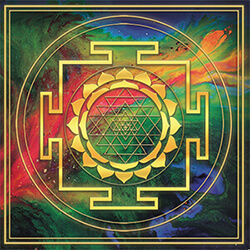
Mandalas and Yantras as Yoga Symbols
One of the most unique and beautiful types of yoga symbols are yantras. These are geometric forms similar to mandalas. Each yantra is dedicated to a different aspect of consciousness, often personified in an Eastern god or goddess.
Differences Between Mandalas and Yantras
Yantras are similar to the more well-known Buddhist mandalas. As noted above, the terms can be used interchangeably, particularly for circular yantras. However, there are several key differences. Mandalas tend to be more complex, sometimes depicting divine beings, human activities, and the heaven world. In other words, mandalas are figurative. On the other hand, yantras are more abstract.
Geometric Forms of Yantras
Yantras tend to be linear and geometric. Yantras in Hinduism are generally simpler than the mandalas often associated with Buddhism. Yantras are composed solely of geometric forms, Sanskrit characters, and organic forms such as lotus petals.
Yantras and Mandalas
Another difference between mandalas and yantras is the intention. Mandalas are often made from fragile or perishable materials and destroyed after creation to emphasize the impermanence of the world. The creation process itself is a meditation. On the other hand, yantras are retained as an ongoing channel and receptacle for divine energy.
Yantras and Sound
Yantras are directly associated with particular sounds or mantras. Yantras are believed to depict the patterns of these sounds in matter. This can be demonstrated with modern cymascopes. A cymascope is a scientific instrument that reveals the patterns created by sound in sand, water, or other substances. This connects the unseen world of sound with the physical or visual dimension.
Symbols Within a Yantra
The word “yantra” means “instrument.” Yantras have a central form with shapes radiating out from the center, including triangles, circles, hexagrams, pentagrams, octagons, lotus petals and tridents. Extensive information about yantras can be found in Yantra Meaning: Powerful Sacred Symbols.
Download artwork on our FREE STUFF page!
Sri Yantra Yoga Symbols
The Sri Yantra represents the union of the divine masculine and feminine. This yoga symbol is composed of nine interlaced triangles with upward triangles meeting downward triangles in a kind of star tetrahedron. The Sri Yantra is the most well-known and widely recognizable of the Hindu yantras. Learn more about the Sri yantra in Yantra Meaning.
Triangles in the Sri Yantra: There are forty-three intersecting triangles organized in nine concentric levels radiating out from the central bindu point. The outer square represents the earth element and forms a stable and solid foundation for the yantra. The square is the power of condensation and manifestation into the world. The four doorways or gates are the thresholds into the outer world.
Symbols in the Sri Yantra: The circle in the center brings focus to the visual form and the mind of the viewer. The lotus petals in this yoga symbol represent creation and life force. The Sri Yantra can be viewed as a map of man’s spiritual journey from the outer to the inner along designated circuits.
Download artwork on our FREE STUFF page!
Ganesha Yantra Yoga Symbols
The Ganesha Yantra utilizes many of the same basic shapes as the Sri Yantra. This yoga symbol uses a six-pointed star in a simplified version of the nine interlocking triangles of the Sri Yantra.
Star Symbolism: The interlocking stars in Ganeha’s yantra symbolizes balance and harmony. Another six-pointed star takes the place of the bindu in the center of the yantra.
Watch nearly 300 videos on our YouTube channel!
Mantra to Ganesha
The mantra associated with this symbol is “Om Gam Ganapataye Namaha” and means “Salutations to the remover of obstacles!” Ganesha is the master of both inner and outer journeys. Ganesha is known for knowledge, patience, preparation and grounding. Learn more and listen to a Ganesha mantra in Ganesha Meaning and Mantras.
Ganesha and the Earth Element
The sheer weight of an elephant is a wonderful metaphor for the earth-based energy necessary for successful projects and endeavors. For example, the energy of Ganesha can form a strong foundation for a new business. The energy of Ganesha can also help to clear away the uncertainty and self-doubt that may hinder a new venture.
Download artwork on our FREE STUFF page!
Lakshmi Yantra Yoga Symbols
The Lakshmi Yantra is dedicated to the Hindu goddess of wealth and abundance. She is also connected to the solar plexus chakra. The geometric forms creating Lakshmi’s Yantra include interlocking triangles, the lotus flower, the circle, square and the gates in each cardinal direction.
Consort of the Goddess Lakshmi
The interlocking triangles are the balance of the masculine and feminine. The consort of Lakshmi is Vishnu, an incarnation of Krishna. There are eight petals in the lotus flower that surrounds the interlocking triangles. The eight petals represent speech, transaction, departure, transcendence, bliss, absence, giving and neglect.
Download artwork on our FREE STUFF page!
Hanuman Yantra Yoga Symbols
The Hanuman yantra contains Sanskrit symbols and words. The letters and sound-syllables from Sanskrit traced on a yantra represent different fundamental thoughtforms. In the case of the Hanuman yantra, the inscription is a specific mantra.
Symbol for OM in the Hanuman Yantra
At the top of the Hanuman yantra is the symbol for OM. OM is associated with the universe in all of its manifestations. Some consider OM to be the hum of creation. Read full article on the history of Hanuman, his powers and the full meaning of his yantra at Hanuman Yantra Meaning.
Download artwork on our FREE STUFF page!
Gayatri Yantra Yoga Symbols
The Gayatri yantra symbol meaning includes multiple layers of spiritual significance. The Gayatri yantra symbol is a visual counterpart for a family of mantras known as the Gayatris. Gayatri is a Vedic poetic meter of twenty-four syllables or any hymn composed in this meter. Hence, there exists a whole family of Gayatri Mantras, all of which serve as meditative aids. Estimates are that there are over 400 Gayatri poems in the Hindu tradition.
Geometry of the Gayatri Yantra
One level of meaning is the geometry used to create the Gayatri yantra. Yantras usually have a central form radiating out from the center. The intent of a yantra is to focus the mind as well as to serve as a repository of spiritual energy. For this reason, yantras can be used as protective devices. Learn more about these beautiful yoga symbols at Gayatri antra Symbol.
Download artwork on our FREE STUFF page!
Durga Yantra Yoga Symbols
The Durga Yantra is based on the idea that it is better to protect yourself and divert misfortune whenever possible. For this reason, the Durga Yantra is viewed as a protection yantra. Durga is a warrioress with indomitable strength. She will help you to let go of anything that is no longer serving you. In addition, she can serve as a shield on many levels as you move through the world.
Watch nearly 300 videos on our YouTube channel!
Characteristics of Durga
Durga cultivates a unique combination of fearlessness, courage and love. The many upward pointing triangles in the yantra emphasize spiritual freedom. Durga’s colors are white, silver, gold, saffron, orange and red. Learn more in Yantra Meaning.
Download artwork on our FREE STUFF page!
Baglamuhki Yantra Yoga Symbols
The Baglamuhki Yantra is a yantra of protection on personal and professional levels. Baglamuhki is a goddess of strength and power, particularly with the power to neutralize gossip and negative speech. For this reason, she is a goddess of protection.
Symbol of the Lotus
The inner lotus flower with eight petals is surrounded by a larger lotus ring with 16 petals. Like many other yantras, the interlocking triangles in the center establish the balance of yin and yang or masculine and feminine. These petals in the larger ring represent the 16 sacred vowels.
Symbolic Meaning of Petals
The sacred vowels correspond to the 10 senses of perception, the five elements and the mind. The yantra or symbol for the throat chakra also has the same 16 petals. Learn more about the Chakra Symbols. The gates on the perimeter of the yantra represent the four cardinal directions. The seeker can enter the yantra symbolically through each of these gates.
Download artwork on our FREE STUFF page!
Surya Yantra Yoga Symbols
The Surya Yantra is sometimes called the Radiance Yantra. The twelve outer petals are known as the celestial beams of the sun. They are symbolic of the twelve months of the year and the twelve astrological signs. The sun is the regal master of the entire solar system and the visible universe.
Colors of the Surya Yantra
The yantra and the mantra are both tools for guiding the thoughts and feelings in healthy patterns, but the viewer’s intention is paramount. When colored, the Surya Yantra is decorated with flaming red, orange, silver and gold.
Benefits of the Surya Yantra
Focusing on the Surya Yantra can be particularly appropriate for extending yourself into new social situations, travel or undertaking adventures in life. Surya is a celebration of light and illumination in yourself and others.
Vedic Astrology Symbols
The use of mantras is a significant part of Vedic astrology. Each planet mantra is said to work in the subtle or unseen realms that influence our lives in every area. Astrology mantras mitigate challenging aspects and amplify positive astrological configurations. Read extensive article at Astrological Mantras.
Sun Symbolism: The sun is usually associated with the masculine. Astrologically speaking, the sun is an expression of the outward self, the self that “shines” towards others. Surya is the Hindu deity who is the source of light or life. Surya is a sun god with a golden chariot driven by Aruna, a personification of the dawn. The chariot is pulled by seven horses representing the seven chakras or energy centers.
Moon Symbolism: In the Hindu tradition, the deity ruling over the moon is called Chandra. The name Chandra means “bright and shining” in Sanskrit. The moon in Vedic astrology represents the mind, including thoughts, feelings, and psychology.
Mars Symbolism: In Vedic astrology, Mars signifies younger siblings, especially a younger brother. Mars is associated with conflict and war on the one hand and valor and defense on the other. On the physical level, Mars is related to the muscular system.
Mercury Symbolism: In Vedic astrology, the planet Mercury is associated with intelligence, logic, speech and friendship. Mercury also governs memory and transportation. Mercury is a messenger, delivering thoughts from one person to another or back and forth between celestial beings.
Venus Symbolism: Venus represents marriage as well as other partnerships. Venus also represents the relationship between the individual and finances or material possessions. Venus is considered to be a refined planet. In order to attain happiness, the individual must change their perceptions in life and balance their karma. Material possessions and partnerships alone will not yield ongoing happiness.
Saturn Symbolism: In Vedic astrology, Saturn is the bearer of karma. Saturn is slow-moving, taking two and a half years to move from one zodiac constellation to another. Saturn brings responsibility and discipline. Saturn is personified in Hinduism as Shani, an incarnation of Krishna.
Jupiter Symbolism: In Vedic astrology, Jupiter is known as Guru (spiritual teacher), Devaguru (teacher of the gods) and Brihaspati (Lord of Light). Jupiter is a planet of work, development, education and higher spiritual insight. Some astrologists view Jupiter as the planet of optimism, success and generosity. Jupiter is immense, mature and benevolent.
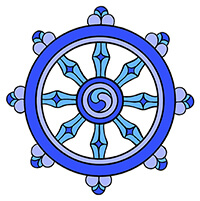
Sacred Buddhist Symbol: Dharmachakra
The most well-known Buddhist symbol is the Wheel of the Law or the Dharmachakra. This wheel represents the teachings of the Buddha. The three swirls in the center represent the three jewels: the teacher, the teaching and the sangha (spiritual community). The Three Jewels, also referred to as the three refuges or the triple gem, form a principle that unites the many diverse sects and schools of Buddhism. Learn more in the article The Three Jewels of Buddhism.
Author Kathleen Karlsen
Kathleen Karlsen is a musician, artist, writer and speaker. She is the author of two books (Flower Symbols and Vocal Medicine) and over 200 articles. Kathleen, her husband Andrew, and their five children live in Bozeman, Montana. More about Kathleen Karlsen.

